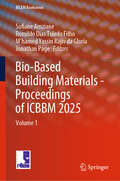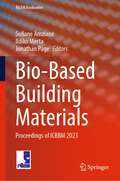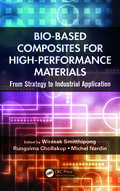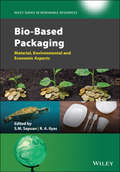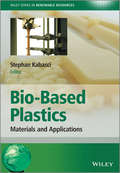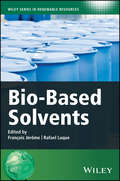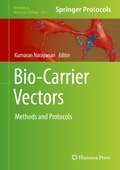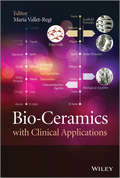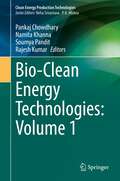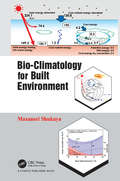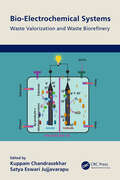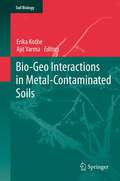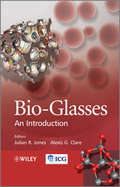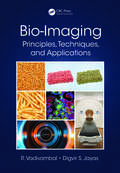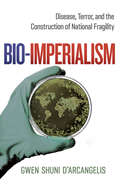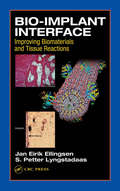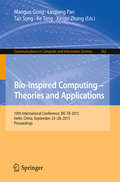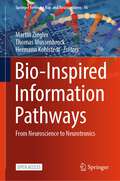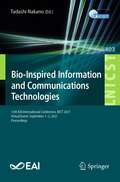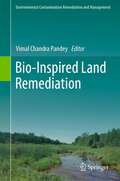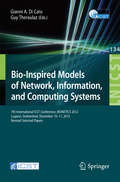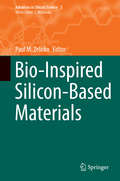- Table View
- List View
Bio-Based Building Materials - Proceedings of ICBBM 2025: Volume 1 (RILEM Bookseries #60)
by Jonathan Page Sofiane Amziane Romildo Dias Toledo Filho M'hamed Yassin Rajiv da GloriaThis book gathers peer-reviewed contributions presented at the 6th International Conference on Bio-Based Building Materials (ICBBM), held in Rio de Janeiro, Brazil on June 17-20, 2025. Focusing on bio-based building materials (3BM) as well as their applications in sustainable building constructions, the contributions highlight the latest findings in this fast-growing field, addressing topics such as natural fibres- and aggregates, ramped earth, innovative hybrid composites based on bio-based ingredients, novel sustainable binders, energy efficiency aspects- and life cycle analysis of these materials.
Bio-Based Building Materials: Proceedings of ICBBM 2023 (RILEM Bookseries #45)
by Jonathan Page Sofiane Amziane Ildiko MertaThis book gathers peer-reviewed contributions presented at the 5th International Conference on Bio-Based Building Materials (ICBBM), held in Vienna, Austria, on June 21-23, 2023. Focusing on bio-based building materials (3BM) as well as their applications in sustainable building constructions, the contributions highlight the latest findings in this fast-growing field, addressing topics such as natural fibres- and aggregates, ramped earth, innovative hybrid composites based on bio-based ingredients, novel sustainable binders, energy efficiency aspects- and life cycle analysis of these materials.
Bio-Based Composites for High-Performance Materials: From Strategy to Industrial Application
by Wirasak Smitthipong Rungsima Chollakup Michel NardinSince synthetic plastics derived from fossil resources are mostly non-biodegradable, many academic and industrial researchers have shifted their attention toward bio-based materials, which are more eco-friendly.Bio-Based Composites for High-Performance Materials: From Strategy to Industrial Application provides an overview of the state-of-art in bi
Bio-Based Packaging: Material, Environmental and Economic Aspects (Wiley Series in Renewable Resource)
by Christian V. StevensAn authoritative and up-to-date review of sustainable packaging development and applications Biobased Packaging explores using renewable and biodegradable materials as sustainable alternatives to non-renewable, petroleum-based packaging. This comprehensive volume surveys the properties of biopolymers, the environmental and economic impact of bio-based packaging, and new and emerging technologies that are increasing the number of potential applications of green materials in the packaging industry. Contributions address the advantages and challenges of bio-based packaging, discuss new materials to be used for food packaging, and highlight cutting-edge research on polymers such as starch, protein, polylactic acid (PLA), pectin, nanocellulose, and their nanocomposites. In-depth yet accessible chapters provide balanced coverage of a broad range of practical topics, including life cycle assessment (LCA) of bio-based packaging products, consumer perceptions and preferences, supply chains, business strategies and markets in biodegradable food packaging, manufacturing of bio-based packaging materials, and regulations for food packaging materials. Detailed discussions provide valuable insight into the opportunities for biopolymers in end-use sectors, the barriers to biopolymer-based concepts in the packaging market, recent advances made in the field of biopolymeric composite materials, the future of bio-plastics in commercial food packaging, and more. This book: Provides deep coverage of the bio-based packaging development, characterization, regulations, and environmental and socioeconomic impact Contains real-world case studies of bio-based packaging applications Includes an overview of recent advances and emerging aspects of nanotechnology for development of sustainable composites for packaging Discusses renewable sources for packaging material and the reuse and recycling of biobased packaging products Biobased Packaging: Material, Environmental and Economic Aspects is essential reading for academics, researchers, and industry professionals working in packaging materials, renewable resources, sustainability, polymerization technology, food technology, material engineering, and related fields.
Bio-Based Plastics
by Christian Stevens Stephan KabasciThe field of bio-based plastics has developed significantly in the last 10 years and there is increasing pressure on industries to shift existing materials production from petrochemicals to renewables.Bio-based Plastics presents an up-to-date overview of the basic and applied aspects of bioplastics, focusing primarily on thermoplastic polymers for material use. Emphasizing materials currently in use or with significant potential for future applications, this book looks at the most important biopolymer classes such as polysaccharides, lignin, proteins and polyhydroxyalkanoates as raw materials for bio-based plastics, as well as materials derived from bio-based monomers like lipids, poly(lactic acid), polyesters, polyamides and polyolefines. Detailed consideration is also given to the market and availability of renewable raw materials, the importance of bio-based content and the aspect of biodegradability.Topics covered include:StarchCellulose and cellulose acetateMaterials based on chitin and chitosanLignin matrix composites from natural resourcesPolyhydroxyalkanoatesPoly(lactic acid)Polyesters, Polyamides and Polyolefins from biomass derived monomersProtein-based plasticsBio-based Plastics is a valuable resource for academic and industrial researchers who are interested in new materials, renewable resources, sustainability and polymerization technology. It will also prove useful for advanced students interested in the development of bio-based products and materials, green and sustainable chemistry, polymer chemistry and materials science.For more information on the Wiley Series in Renewable Resources, visit www.wiley.com/go/rrs
Bio-Based Solvents
by François Jérôme Rafael LuqueA multidisciplinary overview of bio-derived solvent applications, life cycle analysis, and strategies required for industrial commercialization This book provides the first and only comprehensive review of the state-of-the-science in bio-derived solvents. Drawing on their own pioneering work in the field, as well as an exhaustive survey of the world literature on the subject, the authors cover all the bases—from bio-derived solvent applications to life cycle analysis to strategies for industrial commercialization—for researchers and professional chemists working across a range of industries. In the increasingly critical area of sustainable chemistry, the search for new and better green solvents has become a top priority. Thanks to their renewability, biodegradability and low toxicity, as well as their potential to promote advantageous organic reactions, green solvents offer the promise of significantly reducing the pernicious effects of chemical processes on human health and the environment. Following an overview of the current solvents markets and the challenges and opportunities presented by bio-derived solvents, a series of dedicated chapters cover all significant classes of solvent arranged by origin and/or chemical structure. Throughout, real-world examples are used to help demonstrate the various advantages, drawbacks, and limitations of each class of solvent. Topics covered include: The commercial potential of various renewably sourced solvents, such as glycerol The various advantages and disadvantages of bio-derived versus petroleum-based solvents Renewably-sourced and waste-derived solvents in the design of eco-efficient processes Life cycle assessment and predictive methods for bio-based solvents Industrial and commercial viability of bio-based solvents now and in the years ahead Potential and limitations of methodologies involving bio-derived solvents New developments and emerging trends in the field and the shape of things to come Considering the vast potential for new and better products suggested by recent developments in this exciting field, Bio-Based Solvents will be a welcome resource among students and researchers in catalysis, organic synthesis, electrochemistry, and pharmaceuticals, as well as industrial chemists involved in manufacturing processes and formulation, and policy makers.
Bio-Carrier Vectors: Methods and Protocols (Methods in Molecular Biology #2211)
by Kumaran NarayananThis detailed book explores techniques used in research efforts to adopt and combine the best capabilities from natural and artificial vector systems to assemble improved delivery technologies aimed for specific applications. The collection discusses vectors other than the traditional viral and non-viral systems and explores ideas for blending the best features of bacteria, nanoparticles, peptides, and hybrid systems for the delivery of biomaterials into cells, as well as a chapter on the application of shotgun proteomics and mass spectrometry as a tool to analyze the proteomic profile changes in cells that result from these interventions. Written in the highly successful Methods in Molecular Biology format, chapters include introductions to their respective topics, lists of the necessary materials and reagents, step-by-step, readily reproducible laboratory protocols, and tips on troubleshooting and avoiding known pitfalls. Authoritative and practical, Bio-Carrier Vectors: Methods and Protocols serves as an ideal guide for researchers working toward harnessing the power of multiple vectors in gene and drug delivery.
Bio-Ceramics with Clinical Applications
by Maria Vallet-RegiThis publication offers a unique approach that links the materials science of bioceramics to clinical needs and applications.Providing a structured account of this highly active area of research, the book reviews the clinical applications in bone tissue engineering, bone regeneration, joint replacement, drug-delivery systems and biomimetism, this book is an ideal resource for materials scientists and engineers, as well as for clinicians.From the contents:Part I Introduction1. Bioceramics2. BiomimeticsPart II Materials3. Calcium Phosphate Bioceramics4. Silica-based Ceramics: Glasses5. Silica-based Ceramics: Mesoporous Silica6. Alumina, Zirconia, and Other Non-oxide Inert Bioceramics7. Carbon-based Materials in BiomedicinePart III Material Shaping8. Cements9. Bioceramic Coatings for Medical Implants10. Scaffold DesigningPart IV Research on Future Ceramics11. Bone Biology and Regeneration12. Ceramics for Drug Delivery13. Ceramics for Gene Transfection14. Ceramic Nanoparticles for Cancer Treatment
Bio-Clean Energy Technologies Volume 2 (Clean Energy Production Technologies)
by Pankaj Chowdhary Soumya Pandit Namita KhannaThis edited book discusses the latest advancements in the area of biofuel development. It covers extensive information regarding different aspects and types of biofuels. The book provides a road map of the various kinds of biofuels available for consideration. It focuses on microbial based power generation, applications of nanotechnology in biofuel development, advancements in molecular techniques, economic and life cycle assessments. The book also highlights the commercialization prospects and economics of the various processes and an overview of the life cycle assessment of the various different kinds of biofuels. The contributors are experienced professors, academicians and scientists associated with renowned laboratories and institutes in India and abroad. This book is of interest to teachers, researchers, biofuel scientists, capacity builders and policymakers. Also the book serves as additional reading material for undergraduate and graduate students. National and international scientists, policy makers will also find this to be a useful read.
Bio-Clean Energy Technologies: Volume 1 (Clean Energy Production Technologies)
by Rajesh Kumar Pankaj Chowdhary Soumya Pandit Namita KhannaThis book discusses the latest advancements in the area of biofuel development. It covers extensive information regarding different aspects and types of biofuels. The book provides a road map of the various different kinds of biofuels available for consideration, including both conventional and advanced algal based biofuels, replete with the economic analysis of their production and implementation. The contributors are experienced professors, academicians and scientists associated with renowned laboratories and institutes in India and abroad. This book is of interest to teachers, researchers, biofuel scientists, capacity builders and policymakers. Also the book serves as additional reading material for undergraduate and graduate students. National and international scientists, policy makers will also find this to be a useful read.
Bio-Climatology for Built Environment
by Masanori ShukuyaIndoor climate is determined by rational lighting, heating, cooling and ventilating systems. For occupants' well-being it should be consistent with how regional outdoor climate works in the flow of radiation via four paths of heat transfer: radiation; convection; conduction; and evaporation. This book starts with the relationship between the human body and its immediate environmental space followed by a brief introduction of passive and active systems for indoor climate conditioning. The nature of light and heat is discussed with a focus on building envelope systems such as walls and windows, and then examined from the viewpoint of thermodynamics and human-biology. Some examples are given to enable a better understanding of luminous and thermal characteristics of our most immediate environment particularly for those professionally involved in environmental planning, designing, and engineering to know about bio-climatic design principle.
Bio-Electrochemical Systems: Waste Valorization and Waste Biorefinery
by Kuppam ChandrasekharThis book addresses electro-fermentation for biofuel production and generation of high-value chemicals and biofuels using organic wastes. It covers the use of microbial biofilm and algae-based bioelectrochemical systems (BESs) for bioremediation and co-generation of valuable chemicals, including their practical applications. It explains BES design, integrated approaches to enhance process efficiency, and scaling-up technology for waste remediation, bio-electrogenesis, and resource recovery from wastewater. Features: Provides information regarding bioelectrochemical systems, mediated value-added chemical synthesis, and waste remediation and resource recovery approaches. Covers the use of microbial biofilm and algae-based bioelectrochemical systems for bioremediation and co-generation of valuable chemicals. Explains waste-to-energy related concepts to treat industrial effluents along with bioenergy generation. Deals with various engineering approaches for chemicals production in eco-friendly manner. Discusses emerging electro-fermentation technology. This book is aimed at senior undergraduates and researchers in industrial biotechnology, environmental science, civil engineering, chemical engineering, bioenergy and biofuels, and wastewater treatment.
Bio-Geo Interactions in Metal-Contaminated Soils (Soil Biology #31)
by Ajit Varma Erika KotheMetal contamination is an increasing ecological and eco-toxicological risk. Understanding the processes involved in metal mobilization, sorption and mineralization in soils are key features for soil bioremediation. Following an introduction to the physical, chemical and biological components of contaminated soils, various chapters address the interactions of soil, microorganisms, plants and the water phase necessary to transfer metals into biological systems. These include topics such as potential hazards at mining sites; rare earth elements in biotic and abiotic acidic systems; manganese redox reactions; biomineralisation, uranium in seepage water; metal-resistant streptomycetes; mycorrhiza in re-forestation; metal (hyper)accummulation in plants; microbial metal uptake; and their potential for bioremediation. This book will be of interest to soil biologists, geologists and chemists, researchers and graduate students, as well as consulting companies and small enterprises involved in bioremediation.
Bio-Glasses: An Introduction
by Alexis Clare Julian JonesThis new work is dedicated to glasses and their variants which can be used as biomaterials to repair diseased and damaged tissues. Bio-glasses are superior to other biomaterials in many applications, such as healing bone by signaling stem cells to become bone cells. Key features: First book on biomaterials to focus on bio-glassesEdited by a leading authority on bio-glasses trained by one of its inventors, Dr Larry HenchSupported by the International Commission on Glass (ICG)Authored by members of the ICG Biomedical Glass Committee, with the goal of creating a seamless textbookWritten in an accessible style to facilitate rapid absorption of informationCovers all types of glasses, their properties and applications, and demonstrates how glass is an attractive improvement to current proceduresOf interest to the biomedical as well as the materials science community. The book covers all types of glasses: traditional glasses, bioactive glasses, sol-gel glasses, phosphate glasses, glass-ceramics, composites and hybrids. Alongside discussion on how bio-glasses are made, their properties, and the reasons for their use, the authors also cover their applications in dentistry, bone regeneration and tissue engineering and cancer treatment. Its solid guidance describes the steps needed to take a new material from concept to clinic, covering the essentials of patenting, scale-up, quality assurance and FDA approval.
Bio-Imaging: Principles, Techniques, and Applications
by Rajagopal Vadivambal Digvir S. JayasHighlights the Emergence of Image Processing in Food and AgricultureIn addition to uses specifically related to health and other industries, biological imaging is now being used for a variety of applications in food and agriculture. Bio-Imaging: Principles, Techniques, and Applications fully details and outlines the processes of bio-imaging applica
Bio-Imperialism: Disease, Terror, and the Construction of National Fragility
by Gwen Shuni D'ArcangelisBio-Imperialism focuses on an understudied dimension of the war on terror: the fight against bioterrorism. This component of the war enlisted the biosciences and public health fields to build up the U.S. biodefense industry and U.S. global disease control. The book argues that U.S. imperial ambitions drove these shifts in focus, aided by gendered and racialized discourses on terrorism, disease, and science. These narratives helped rationalize American research expansion into dangerous germs and bioweapons in the name of biodefense and bolstered the U.S. rationale for increased interference in the disease control decisions of Global South nations. Bio-Imperialism is a sobering look at how the war on terror impacted the world in ways that we are only just starting to grapple with.
Bio-Implant Interface: Improving Biomaterials and Tissue Reactions
by J.E. Ellingsen S.P. LyngstadaasAchieving good clinical outcomes with implanted biomaterials depends upon achieving optimal function, both mechanical and biological, which in turn depends upon integrating advances realized in biological science, material science, and tissue engineering. As these advances push back the frontiers of biomaterial medicine , the control and patterning
Bio-Inspired Artificial Intelligence: Theories, Methods, and Technologies
by Dario Floreano Claudio MattiussiNew approaches to artificial intelligence spring from the idea that intelligence emerges as much from cells, bodies, and societies as it does from evolution, development, and learning. Traditionally, artificial intelligence has been concerned with reproducing the abilities of human brains; newer approaches take inspiration from a wider range of biological structures that that are capable of autonomous self-organization. Examples of these new approaches include evolutionary computation and evolutionary electronics, artificial neural networks, immune systems, biorobotics, and swarm intelligence--to mention only a few. This book offers a comprehensive introduction to the emerging field of biologically inspired artificial intelligence that can be used as an upper-level text or as a reference for researchers. Each chapter presents computational approaches inspired by a different biological system; each begins with background information about the biological system and then proceeds to develop computational models that make use of biological concepts. The chapters cover evolutionary computation and electronics; cellular systems; neural systems, including neuromorphic engineering; developmental systems; immune systems; behavioral systems--including several approaches to robotics, including behavior-based, bio-mimetic, epigenetic, and evolutionary robots; and collective systems, including swarm robotics as well as cooperative and competitive co-evolving systems. Chapters end with a concluding overview and suggested reading.
Bio-Inspired Computing -- Theories and Applications: 10th International Conference, BIC-TA 2015 Hefei, China, September 25-28, 2015, Proceedings (Communications in Computer and Information Science #562)
by Maoguo Gong Linqiang Pan Tao Song Ke Tang Xingyi ZhangThis book constitutes the proceedings of the 10th International Conference on Bio-Inspired Computing: Theories and Applications, BIC-TA 2015, held in Hefei, China, in September 2015. The 63 revised full papers presented were carefully reviewed and selected from 182 submissions. The papers deal with the following main topics: evolutionary computing, neural computing, DNA computing, and membrane computing.
Bio-Inspired Information Pathways: From Neuroscience to Neurotronics (Springer Series on Bio- and Neurosystems #16)
by Martin Ziegler Thomas Mussenbrock Hermann KohlstedtThis open access book offers a timely and comprehensive review of the field of neurotronics. Gathering cutting-edge contributions from neuroscientists, biologists, psychologists, as well as physicists, microelectronics engineers and information scientists, it gives extensive information on fundamental information pathways in selected nervous systems. It also highlights their relevance as building blocks for novel computing architectures, such as bio-inspired electronic devices, neuromorphic architectures, memristive devices, adaptive sensors and emergent, pulsed-coupled oscillatory networks. All in all, this book offers a unique bridge between fundamental research in neuroscience, neural information processing, nonlinear dynamics, and self-organization, and advanced practical applications concerning the fabrication of hardware-oriented computing.
Bio-Inspired Information and Communications Technologies: 13th EAI International Conference, BICT 2021, Virtual Event, September 1–2, 2021, Proceedings (Lecture Notes of the Institute for Computer Sciences, Social Informatics and Telecommunications Engineering #403)
by Tadashi NakanoThis book constitutes the refereed conference proceedings of the 13th International Conference on Bio-inspired Information and Communications Technologies, held in September 2021. Due to the safety concerns and travel restrictions caused by COVID-19, BICT 2021 took place online in a live stream. BICT 2021 aims to provide a world-leading and multidisciplinary venue for researchers and practitioners in diverse disciplines that seek the understanding of key principles, processes and mechanisms in biological systems and leverage those understandings to develop novel information and communications technologies (ICT). The 20 full and 2 short papers were carefully reviewed and selected from 47 submissions. The papers are organized thematically in tracks as follows: Bio-inspired network systems and applications; Bio-inspired information and communication; mathematical modelling and simulations of biological systems.
Bio-Inspired Land Remediation (Environmental Contamination Remediation and Management)
by Vimal Chandra PandeyLand is fundamental to the human life. The upper layer of land is a non-renewable resource, and source of food. Therefore, land health is essential to long-term food security and to promote sustainable livelihoods. On account of urbanization, industrialization and population growth, land pollution is one of the major issues worldwide. As a result, land pollution is continuing across the world, and has been linked with a wide range of potentially toxic contaminants at rates that deteriorate land quality. Land pollution can result either anthropogenic activities or natural activities. The major contaminants of land pollution are metalloids, petroleum hydrocarbon, radioactive elements, polyaromatic hydrocarbons (PAHs), Pesticide, other organic pollutants, etc. that comes from different types of sources. In urban and peri-urban areas, irrigation of agricultural land with polluted water is also a reason of land pollution. Therefore, land security is an important issue for future sustainability. Its remediation and management are important issue worldwide to protect land quality and functions. Land pollution means degradation of earth's surface. Polluted land comes under the category of degraded land. Hence, the remediation of polluted land is essential for regaining biodiversity and ecosystems services and thereby achieving United Nations-Sustainable Development Goals (UN-SDGs).This fact showed the need to develop research into land remediation. Bio-inspired land remediation has undergone a huge development. Therefore, Biomanagement has a lot of potential to secure upper earth’s surface through the land remediation programs targeted during the United Nations Decade on Ecosystem Restoration (2021-2030). This book explores the remediation of land pollution that includes Phytoremediation, Bioremediation (bacterial remediation and fungal remediation), Vermiremediation, Biochar-based remediation and other Bio-inspired remediation. This book will be a remarkable asset for research scholars, environmentalists, ecological scientist, agriculturist, practitioners, policy makers, entrepreneurs, and other stakeholders alike.
Bio-Inspired Models of Network, Information, and Computing Systems: 7th International ICST Conference, BIONETICS 2012, Lugano, Switzerland, December 10--11, 2012, Revised Selected Papers (Lecture Notes of the Institute for Computer Sciences, Social Informatics and Telecommunications Engineering #134)
by Gianni A. Di Caro Guy TheraulazThis book constitutes the thoroughly refereed post-conference proceedings of the 7th International Conference on Bio-Inspired Models of Network, Information and Computing Systems (Bionetics 2012), held in Lugano, Switzerland, in December 2012. The 23 revised full papers presented were carefully reviewed and selected from 40 submissions. They cover topics such as networking, robotics and neural networks, molecular scale and bioinformatics, optimization and bio-inspired modeling in various fields.
Bio-Inspired Silicon-Based Materials (Advances in Silicon Science #5)
by Paul M. ZeliskoThe contributed volume addresses a wide range of topics including, but not limited to, biotechnology, synthetic chemistry, polymer chemistry and materials chemistry. The book will serve as a specialized review of the field of biologically inspired silicon-based structures. Researchers studying biologically inspired silicon materials chemistry will find this volume invaluable.
Bio-MEMS: Technologies and Applications
by Wanjun Wang Steven A. SoperThis book considers both the unique characteristics of biological samples and the challenges of microscale engineering. Divided into three main sections, it first examines fabrication technologies using non-silicon processes, which are suitable for the materials more commonly used in medical/biological analyses. These include UV lithography, LIGA, nanoimprinting, and hot embossing. Attention then shifts to microfluidic components and sensing technologies for sample preparation, delivery, and analysis in microchannels and microchambers. The final section outlines various applications and systems at the leading edge of Bio-MEMS technology in a variety of areas such as drug delivery and proteomics.
